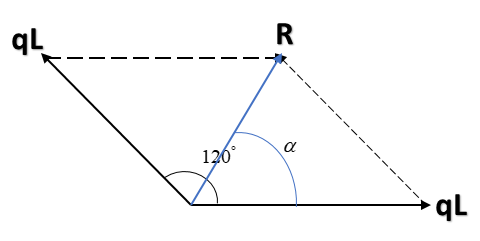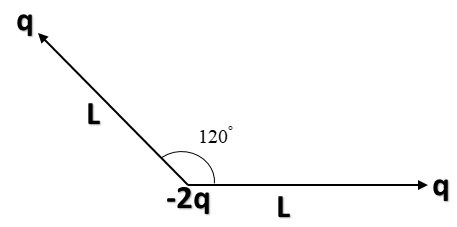Answer
402.9k+ views
Hint: Electric dipole is a setup of two charges in which two charges of equal magnitude are placed at a very small distance from each other. One must know the true meaning of ‘pole’. Monopole means a system of single charge. Hence the monopole of a system is the net value of charge contained within a region. When considered the system of two charges separated by some distance, it’s called electric dipole.
Formula used:
$\vec p = q(L)\hat L$,$R = \sqrt{A^2+B^2+2ABcos\theta}$and $\alpha =tan^{-1}{ \dfrac{\vec B sin \theta}{\vec B cos \theta + A}}$.
Complete answer:
Dipole moment of the system of two charges is denoted by ‘p’ where $\vec p = q(L)\hat L$, and in this formula, we take charge of any one and distance between them. Dipole moment is defined for charges of the same magnitude. It is a vector quantity with direction from +q to –q, which is the meaning of$\hat L$. Now, in the diagram, as the two systems of charges are inclined at some angle, hence we have to perform vector addition to find their resultant.
Now, both the systems of charges have the same dipole moment ‘qL’.
Hence adding them using vector addition.

Thus using,$R = \sqrt{A^2+B^2+2ABcos\theta}$, we get;
$R = \sqrt{(qL)^2+(qL)^2+2(qL)(qL)cos120^{\circ}}$
$R = \sqrt{2(qL)^2+2(qL)(qL)\dfrac{-1}{2} }$
$R = \sqrt{2(qL)^2 - (qL)^2} = qL$
Hence the resultant dipole moment of the system is ‘qL’.
Now, using;
$\alpha =tan^{-1}{ \dfrac{\vec B sin \theta}{\vec B cos \theta + A}}$
$\alpha =tan^{-1}{ \dfrac{qL sin 120^{\circ}}{qL cos 120^{\circ} + qL}}$
$\alpha =tan^{-1}{ \dfrac{qL \dfrac{\sqrt 3}{2}}{qL \dfrac{-1}{2}+ qL}} = tan^{-1}\sqrt 3$
Hence, $\alpha = 60^{\circ}$.
Hence, the dipole moment of the system is ‘qL’ acting at an angle $\alpha = 60^{\circ}$ from the x-axis.
Note:
Whenever representing a vector quantity, it’s always mandatory to mention both magnitude and direction of the vector otherwise it will be like a car without wheels. Students are always advised to represent the complete vector while practicing the subject so that it could become a habit. Also, the direction of dipole moment is along the length and directed from negative charge to the positive.
Formula used:
$\vec p = q(L)\hat L$,$R = \sqrt{A^2+B^2+2ABcos\theta}$and $\alpha =tan^{-1}{ \dfrac{\vec B sin \theta}{\vec B cos \theta + A}}$.
Complete answer:
Dipole moment of the system of two charges is denoted by ‘p’ where $\vec p = q(L)\hat L$, and in this formula, we take charge of any one and distance between them. Dipole moment is defined for charges of the same magnitude. It is a vector quantity with direction from +q to –q, which is the meaning of$\hat L$. Now, in the diagram, as the two systems of charges are inclined at some angle, hence we have to perform vector addition to find their resultant.
Now, both the systems of charges have the same dipole moment ‘qL’.
Hence adding them using vector addition.

Thus using,$R = \sqrt{A^2+B^2+2ABcos\theta}$, we get;
$R = \sqrt{(qL)^2+(qL)^2+2(qL)(qL)cos120^{\circ}}$
$R = \sqrt{2(qL)^2+2(qL)(qL)\dfrac{-1}{2} }$
$R = \sqrt{2(qL)^2 - (qL)^2} = qL$
Hence the resultant dipole moment of the system is ‘qL’.
Now, using;
$\alpha =tan^{-1}{ \dfrac{\vec B sin \theta}{\vec B cos \theta + A}}$
$\alpha =tan^{-1}{ \dfrac{qL sin 120^{\circ}}{qL cos 120^{\circ} + qL}}$
$\alpha =tan^{-1}{ \dfrac{qL \dfrac{\sqrt 3}{2}}{qL \dfrac{-1}{2}+ qL}} = tan^{-1}\sqrt 3$
Hence, $\alpha = 60^{\circ}$.
Hence, the dipole moment of the system is ‘qL’ acting at an angle $\alpha = 60^{\circ}$ from the x-axis.
Note:
Whenever representing a vector quantity, it’s always mandatory to mention both magnitude and direction of the vector otherwise it will be like a car without wheels. Students are always advised to represent the complete vector while practicing the subject so that it could become a habit. Also, the direction of dipole moment is along the length and directed from negative charge to the positive.
Recently Updated Pages
What are biodiversity hotspots Name the biodiversity class 10 biology CBSE

What are biodegradable substances Give two example class 10 biology CBSE

Area of retina devoid of rods and cones is A Yellow class 10 biology CBSE

What are antibiotics Give five examples of bacteria class 10 biology CBSE

What are analogous organs Give two examples class 10 biology CBSE

Why are alluvial soils also called riverine soils class 10 biology CBSE

Trending doubts
Difference Between Plant Cell and Animal Cell

Which are the Top 10 Largest Countries of the World?

Fill the blanks with the suitable prepositions 1 The class 9 english CBSE

Give 10 examples for herbs , shrubs , climbers , creepers

Difference between Prokaryotic cell and Eukaryotic class 11 biology CBSE

Select the word that is correctly spelled a Twelveth class 10 english CBSE

Fill the blanks with proper collective nouns 1 A of class 10 english CBSE

Change the following sentences into negative and interrogative class 10 english CBSE

The Buddhist universities of Nalanda and Vikramshila class 7 social science CBSE




